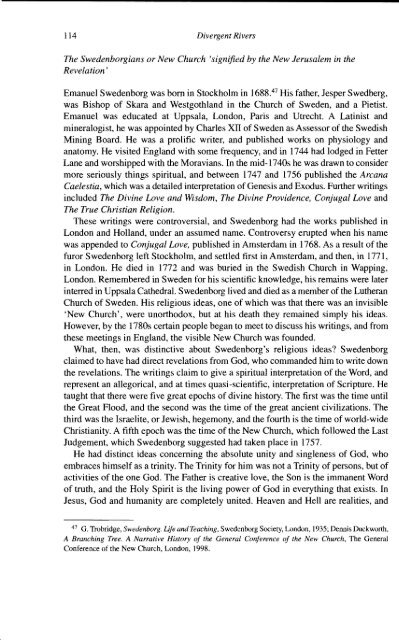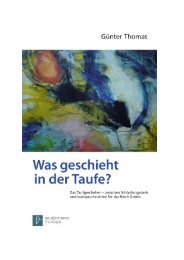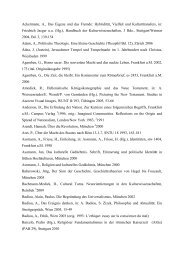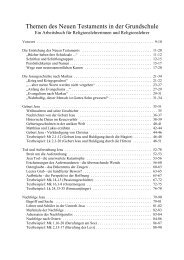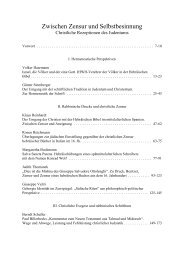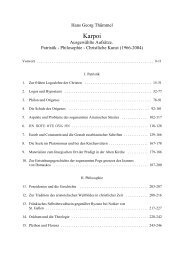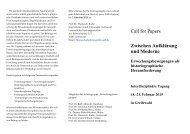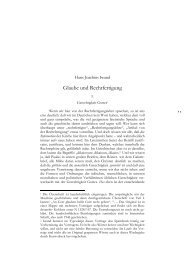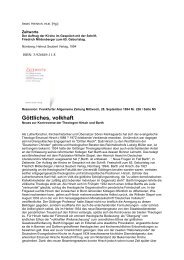The Radical Reformation Tradition: Anabaptists, English Separatists ...
The Radical Reformation Tradition: Anabaptists, English Separatists ...
The Radical Reformation Tradition: Anabaptists, English Separatists ...
- No tags were found...
You also want an ePaper? Increase the reach of your titles
YUMPU automatically turns print PDFs into web optimized ePapers that Google loves.
114 Divergent Rivers<strong>The</strong> Swedenborgians or New Church 'signified by the New Jerusalem in theRevelation'Emanuel Swedenborg was born in Stockholm in 1688. 47 His father, Jesper Swedberg,was Bishop of Skara and Westgothland in the Church of Sweden, and a Pietist.Emanuel was educated at Uppsala, London, Paris and Utrecht. A Latinist andmineralogist, he was appointed by Charles XII of Sweden as Assessor of the SwedishMining Board. He was a prolific writer, and published works on physiology andanatomy. He visited England with some frequency, and in 1744 had lodged in FetterLane and worshipped with the Moravians. In the mid-1740s he was drawn to considermore seriously things spiritual, and between 1747 and 1756 published the ArcanaCaelestia, which was a detailed interpretation of Genesis and Exodus. Further writingsincluded <strong>The</strong> Divine Love and Wisdom, <strong>The</strong> Divine Providence, Conjugal Love and<strong>The</strong> True Christian Religion.<strong>The</strong>se writings were controversial, and Swedenborg had the works published inLondon and Holland, under an assumed name. Controversy erupted when his namewas appended to Conjugal Love. published in Amsterdam in 1768. As a result of thefuror S wedenborg left Stockholm, and settled first in Amsterdam, and then, in 1771,in London. He died in 1772 and was buried in the Swedish Church in Wapping,London. Remembered in Sweden for his scientific knowledge, his remains were laterinterred in Uppsala Cathedral. Swedenborg lived and died as a member of the LutheranChurch of Sweden. His religious ideas, one of which was that there was an invisible'New Church', were unorthodox, but at his death they remained simply his ideas.However, by the 1780s certain people began to meet to discuss his writings, and fromthese meetings in England, the visible New Church was founded.What, then, was distinctive about Swedenborg's religious ideas? Swedenborgclaimed to have had direct revelations from God, who commanded hirn to write downthe revelations. <strong>The</strong> writings claim to give a spiritual interpretation of the Word, andrepresent an allegorieal, and at times quasi-scientific, interpretation of Scripture. Hetaught that there were five great epochs of divine history. <strong>The</strong> first was the time untilthe Great Flood, and the second was the time of the great ancient civilizations. <strong>The</strong>third was the Israelite, or Jewish, hegemony, and the fourth is the time of world-wideChristianity. A fifth epoch was the time of the New Church, which followed the LastJudgement, which Swedenborg suggested had taken place in 1757.He had distinct ideas concerning the absolute unity and singleness of God, whoembraces hirnself as a trinity. <strong>The</strong> Trinity for hirn was not a Trinity of persons, but ofactivities of the one God. <strong>The</strong> Father is creative love, the Son is the immanent Wordof truth, and the Holy Spirit is the living power of God in everything that exists. InJesus, God and humanity are completely united. Heaven and Hell are realities, and47 G. Trobridge, Swedenborg. Ule andTeaching. Swedenborg Society. London, 1935; Dennis Duckworth,A Branching Tree. A Narrative His/ory 01 the General Conference 01 the New Church. <strong>The</strong> GeneralConference of the New Church, London, 1998.


